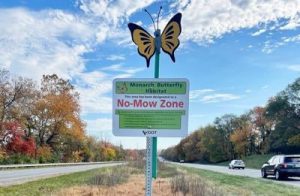States give pollinators pit stops in rights-of-way
No-mow zones create habitat, save time and money
By: Whitney Pipkin

A sign on VA State Route 7 near Purcellville lets drivers and maintenance crews know that the median is used to grow habitat for pollinators.
Here’s an item to add to your bingo card for long car drives: “no-mow” signs.
More highways and byways across the region are posting them next to strips of land — in medians, at intersections and along shoulders and curbs — as part of reduced mowing practices being integrated into their culture.
Mowing less frequently or avoiding it all together during certain times of year helps to leave habitat for native and pollinator-friendly plants, such as milkweed, when migrating monarchs and other wildlife need them most. Less mowing also means less pollution from gas-powered mowers, and there are financial incentives, too.
“The reduction in mowing has been a significant savings in both money and in time,” said Bill Lewis, state roadside program supervisor for the Virginia Department of Transportation. Spending about half as much time on mowing, he said, means the crews have the opportunity for other activities, like fixing road shoulders and potholes.
National volunteer programs also encourage state transportation authorities and energy companies to dedicate more of their rights-of-way to improved habitats that often require less maintenance and benefit local species. And many states have their own pollinator-focused programs and reasons for promoting them.
Pennsylvania’s Department of Transportation participates in a voluntary pollinator conservation program that tracks acres set aside as habitat for species that may soon be listed under the Endangered Species Act, such as monarch butterflies. The state enrolled more than 4,000 acres in the program, reducing mowing and implementing other conservation practices on those lands.
In addition to reduced mowing practices, the Maryland Department of Transportation introduced its pollinator habitat plan in 2017 in response to state legislation the year before. The plan sets aside locations such as welcome centers, rest areas and other government facilities for pollinator habitat gardens, creating five in 2019.
Maryland also implemented a revised mowing program in 2010 to benefit wildlife habitat. The agency doubled down on the effort in more recent years with turfgrass management guidelines that ensure most right-of-way grasses are not mowed until they have reached a height of 18 inches or are in areas where they impede drivers’ visibility.
The Virginia Department of Transportation has taken many of the same steps, starting by planting a different type of fescue grass that is bred to be shorter and mowed less frequently. But that was just the beginning of what Lewis describes as a slow cultural shift for the agency — and for the drivers who frequent the region’s roads.
The public appears to be divided on the subject. “I would say I get an equal number of calls from people who are upset that we have mowed as people upset that we have not mowed,” he said with a laugh.
To read the complete article go to; States give pollinators pit stops in rights-of-way | Wildlife & Habitat | bayjournal.com
We are here to share current happenings in the bee industry. Bee Culture gathers and shares articles published by outside sources. For more information about this specific article, please visit the original publish source: States give pollinators pit stops in rights-of-way | Wildlife & Habitat | bayjournal.com






